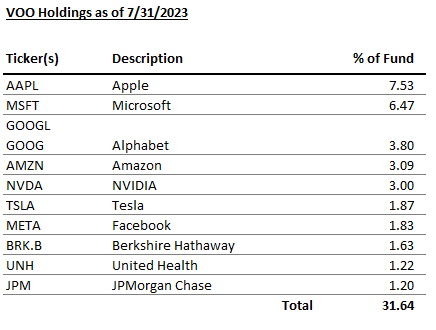Take a look at the top 10 holdings from Vanguard’s 500 Index ETF (VOO):

There are 500 stocks in this fund, but 10 of them account for almost 1/3rd of the total assets. Needless to say, we might be able to describe this as “top heavy”.
This a fairly common occurrence with funds like VOO. These funds use a market-cap weighting scheme to drive the composition of the fund holdings. In simple terms, this means that the more valuable the company, the higher weight it will have in the fund.
And this can often lead evidence-based investors to have the logical thought, “Hold up! I thought I wanted a highly diversified fund! But most of my money is invested in only a few companies.”
Benefits of market-cap weighting
So why are most passive funds set up this way and why are they so popular? Well, there are a couple reasons.
To start, market-cap weighting closely mirrors the “whole of market” approach to passive investing. You essentially own the entire index as it exists in the real world.
Market-cap weighting also reduces turnover. The weights of individual holdings float with the changing market values of each company in the index, so there is little need to make large rebalancing trades (unless you change the roster of companies in the index). The index essentially keeps itself in balance.
This lack of turnover can help save on taxes. If the fund doesn’t need to trade a lot, then it’s unlikely that the fund will be forced to make large capital gains distributions each year. However, with the advent of exchange-traded funds (ETFs), the relative tax impacts have likely diminished somewhat.
The final main benefit of a market-cap weighting scheme revolves around the concept of financial or investing “momentum”. Momentum is the idea that you should invest more into companies that are doing well (rising share price) and less into companies doing poorly (falling share price). Market-cap weighting does this by default.
In his most recent shareholder letter, Warren Buffett described the idea that most of your investment success will come down to a few companies soaring above the rest.
The lesson for investors: The weeds wither away in significance as the flowers bloom. Over time, it takes just a few winners to work wonders.
Warren Buffett – 2022 Berkshire Hathaway Shareholder Letter
You may have also heard the saying, “the trend is your friend.” Again, just another plug for momentum.
There is academic support for following a momentum based investment strategy. You can find a host of academic journal entries here.
But what about equal weight funds?
However, there are many investors who can be turned off by market-cap weighting. And many of these same folks often explore equal weight funds as a potential solution.
Instead of weighting each investment based on market value, an equal weight fund just buys the same amount of each company and rebalances back to the equal weight every few months. In essence, equal weight funds try to cancel out the momentum effect over time.
So is this a better approach to investing? It’s tough to say.
In theory, equal weight funds should offer more exposure to smaller and “value” companies, in addition to the lower momentum exposure I mentioned earlier.
However, equal weight funds incur some downsides as well, namely the loss of momentum and higher expenses.
And don’t forget that an equal weight fund represents a “second guessing” of the broader wisdom incorporated in the stock market. For example, if the market is telling me that Apple is the most valuable company in the world, who am I to doubt the veracity of that proposition? As evidence-based investors, we should think long and hard before we deviate from the collective wisdom of the markets. The market may not always be right, but it’s damn hard to determine when it’s wrong.
Another minor thing to consider is mergers and divestitures. For example, what happens if Apple buys Disney? In a market-cap weighted fund, your economic exposure to the combined entity is about the same as it was before the merger. However, in an equal weight fund, you would lose half of your exposure to Apple/Disney upon completion of the merger. A divestiture would create a similar dynamic. This doesn’t make much sense from investment standpoint.
In the end, the choice really comes down to personal preference. Equal weight funds could make sense for some investors, but maybe not for others. It’s might also be possible to gain the benefits of equal weighting in other ways.
For example, why not add layer on exposure to market-cap weighted funds targeted specifically at small or value companies? This is known as “factor” investing, which was pioneered by the Fama-French three-factor model and there is significant academic support for this approach. You would gain most of the benefits of an equal weight approach and likely do so at a lower cost.

